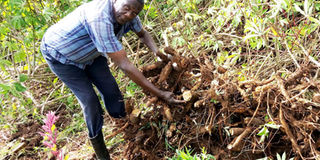Strange disease attacks cassava gardens in Nebbi

Mr James Kerchan, a farmer, shows some of the rotten cassava tubers attacked by the disease in Nebbi District on Monday. PHOTO/PATRICK OKABA
What you need to know:
- Ms Joyce Piwa, the district production officer, who is also focal point person for ACDP in the area, said the cassava plantations could have been attacked by both brown streak and soft root diseases, with about 40 per cent of the 647 registered farmers affected.
- According to the Food and Agriculture Organisation (FAO), Cassava brown streak is a devastating disease that causes loss of root (tuber) production and quality
More than 600 cassava farmers in Nebbi District are counting losses after a strange disease destroyed their plantations.
The affected farmers are beneficiaries of government’s Agricultural Cluster Development Programme (ACDP), which supports cassava growing for commercial purposes.
The farmers were mobilised in 2018 to plant Nasse-19, a cassava variety which matures in one-and half years, with the aim of supplying factories in the district.
However, the farmers say the disease attacks cassava and make it rot before maturity.
Mr James Kerchan, a farmer in Kaal-Wang Village, Nebbi Sub-county, on Wednesday said he spent about Shs4m to plant four acres of cassava but his whole garden has been attacked by the disease.
“The cassava is just rotting and I cannot sell it. Almost half an acre of cassava, which I had propagated, is rotten. I spent Shs42,000 to procure cassava cuttings per bag,” he said.
The disease attacks the cassava tubers, making them turn yellow as they rot.
Mr Kerchan added that they were told to open bank accounts with the promise of additional financial support under ACDP but nothing has so far come through. He said this support would help them find drugs to fight the disease.
Another affected farmer, Ms Merriam Akai, said she had hoped to reap from cassava farming but the disease has left her disappointed.
“I thought cassava production would be the only enterprise to venture into as a boost to our livelihoods but our hopes are buried with the cassava getting rotten on a large scale,” Ms Akai said.
Ms Joyce Piwa, the district production officer, who is also focal point person for ACDP in the area, said the cassava plantations could have been attacked by both brown streak and soft root diseases, with about 40 per cent of the 647 registered farmers affected. “Farmers from Parombo and Nebbi sub-counties are the most affected. This will affect the supply of cassava products to the mini-factories and hence losses to both farmers and government,” she said.
Ms Piwa admitted that the ACDP project, which is set to end in 2022, has registered enormous challenges due to delay by factories to procure the cassava from the farmers.
Implementation of ACDP project under the Ministry of Agriculture, Animal Industry and Fisheries started in 2018.
The project is meant to increase cassava production and marketing of selected agricultural commodities such as beans, maize, rice, cassava and coffee. But the project has been beset by a number of challenges.
At the launch of the project in Nebbi District, the cassava farmers were promised Shs500 per kg of raw cassava from the cooperative members to boost the factory demand but this has not been realised.
According to the Food and Agriculture Organisation (FAO), cassava brown streak is a devastating disease that causes loss of root (tuber) production and quality. The disease is spread through planting of stem cuttings from infected plants.
Soft rot disease is caused by pathogens that secrete enzymes capable of decomposing cell wall structures, thereby destroying the texture of plant tissue making the plant tissue become macerated (soft and watery).
Background
According to the Food and Agriculture Organisation (FAO), Cassava brown streak is a devastating disease that causes loss of root (tuber) production and quality. The disease is spread through planting of stem cuttings from infected plants. The virus also spreads from plant to plant by white flies. Symptoms of the disease can be observed on leaves, stems and cassava roots.




